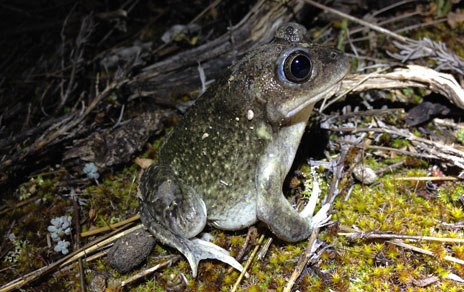Construcción de balsas para la recuperación de anfibios en el Majal Blanco, enmarcado en la programación de actividades de sensibilización e información ambiental. Concejalía de Urbanismo, Medio Ambiente y Huerta del Ayuntamiento de Murcia. sábado 17 de marzo de 2018, de 10:00 a 14:00 horas. Murcia. Leer más.





¿Sabes distinguir el sonido de las diferentes especies de ranas? ¿Y el canto de los sapos? ¿Sabías que hay una especie que canta como una gallina excitada? ¿Y otra como el Autillo? Hoy en Bicheando.net te ayudamos a responder a estas preguntas y a identificar estos cantos, con muchos ejemplos audiovisuales. Leer más.

Investigadores del Museo Nacional de Ciencias Naturales (MNCN-CSIC) han analizado cómo la Sierra de Guadarrama condiciona la conectividad entre las poblaciones de cuatro anfibios ibéricos: la ranita de San Antonio, Hyla molleri, el sapo corredor, Epidalea calamita, la rana verde común, Pelophylax perezi, y el sapo de espuelas, Pelobates cultripes. El estudio, publicado en Journal of Biogeography, muestra que para el sapo de espuelas la sierra de Guadarrama supone una barrera difícil de superar, pero para el resto de especies actúa como un filtro semipermeable. Leer más.

Following a request from EFSA, the Panel on Plant Protection Products and their Residues developed an opinion on the science to support the potential development of a risk assessment scheme of plant protection products for amphibians and reptiles. The coverage of the risk to amphibians and reptiles by current risk assessments for other vertebrate groups was investigated. Available test methods and exposure models were reviewed with regard to their applicability to amphibians and reptiles. Proposals were made for specific protection goals aiming to protect important ecosystem services and taking into consideration the regulatory framework and existing protection goals for other vertebrates. Uncertainties, knowledge gaps and research needs were highlighted. Ir al enlace.
| Vacancy #: | 2746 |
| Unit: | Global Species & Key Biodiversity Areas Programme |
| Organization: | International Union for Conservation of Nature (IUCN) |
| Location: | European Regional Office, Brussels, Belgium |
| Reporting to: | Director – Global Species & KBA Programme |
| Work percentage: | 100% |
| Grade: | P2 |
| Expected start date: | 03 April 2018 |
| Type of contract: | Fixed-term (12 months with possibility of renewal) |
| Closing date: | 12 March 2018 |
Ir al enlace.






